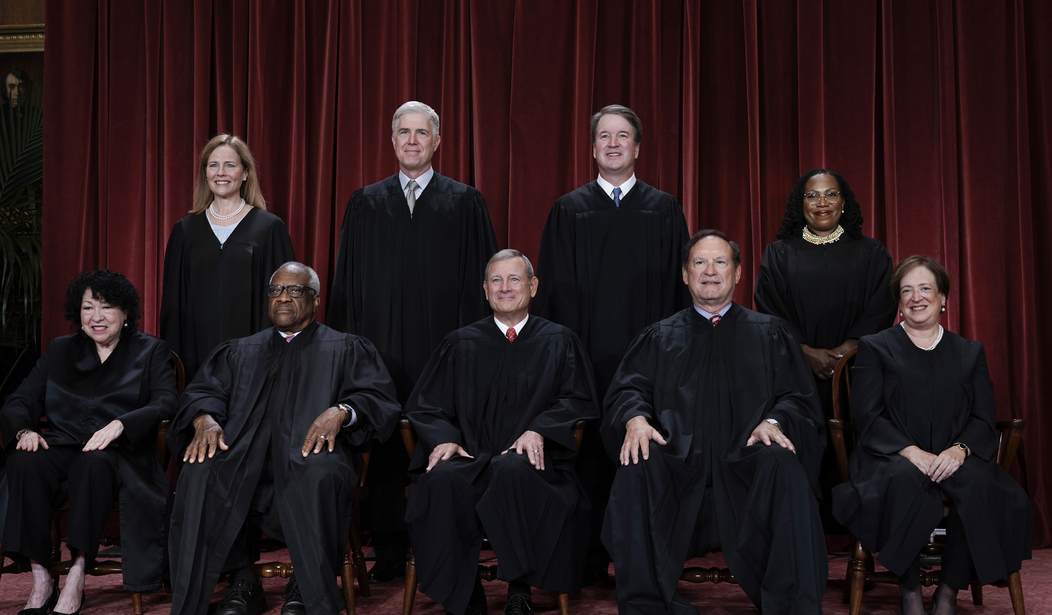“Eliminating racial discrimination,” Chief Justice John Roberts writes in today’s ruling, “means eliminating all of it.” That ruling released just minutes ago swept aside decades of affirmative-action programs at Harvard, the University of North Carolina, and likely everywhere — even if Roberts reserved a narrow test on other challenges.
The 6-3 decision comes nearly two decades after Roberts’ warning that affirmative action’s days were numbered. Day Zero has apparently arrived in Students for Fair Admissions v Harvard. This comes from the syllabus:
Eliminating racial discrimination means eliminating all of it. Accordingly, the Court has held that the Equal Protection Clause applies “without regard to any differences of race, of color, or of nationality”— it is “universal in [its] application.” Yick Wo v. Hopkins, 118 U. S. 356, 369. For “[t]he guarantee of equal protection cannot mean one thing when applied to one individual and something else when applied to a person of another color.” Regents of Univ. of Cal. v. Bakke, 438 U. S. 265, 289–290.
Any exceptions to the Equal Protection Clause’s guarantee must survive a daunting two-step examination known as “strict scrutiny,” Adarand Constructors, Inc. v. Peña, 515 U. S. 200, 227, which asks first whether the racial classification is used to “further compelling governmental interests,” Grutter v. Bollinger, 539 U. S. 306, 326, and second whether the government’s use of race is “narrowly tailored,” i.e., “necessary,” to achieve that interest, Fisher v. University of Tex. at Austin, 570 U. S. 297, 311–312. Acceptance of race-based state action is rare for a reason: “[d]istinctions between citizens solely because of their ancestry are by their very nature odious to a free people whose institutions are founded upon the doctrine of equality.” Rice v. Cayetano, 528 U. S. 495, 517. Pp. 9–16. …
But the Court has permitted race-based college admissions only within the confines of narrow restrictions: such admissions programs must comply with strict scrutiny, may never use race as a stereotype or negative, and must—at some point—end. Respondents’ admissions systems fail each of these criteria and must therefore be invalidated under the Equal Protection Clause of the Fourteenth Amendment. Pp. 21–34.
Also in the syllabus comes a description of the programs at Harvard and UNC that hardly reflects well on their administrations:
Because Harvard’s and UNC’s admissions programs lack sufficiently focused and measurable objectives warranting the use of race, unavoidably employ race in a negative manner, involve racial stereotyping, and lack meaningful end points, those admissions programs cannot be reconciled with the guarantees of the Equal Protection Clause. At the same time, nothing prohibits universities from considering an applicant’s discussion of how race affected the applicant’s life, so long as that discussion is concretely tied to a quality of character or unique ability that the particular applicant can contribute to the university. Many universities have for too long wrongly concluded that the touchstone of an individual’s identity is not challenges bested, skills built, or lessons learned, but the color of their skin. This Nation’s constitutional history does not tolerate that choice. Pp. 39–40.
This language seems more broadly applied than in just college admissions. Roberts frames this opinion as aimed at racial discrimination in toto, and then outlines only two exceptions that can survive a strict-scrutiny test. Neither applies to education on an industrial level, emphasis mine:
Outside the circumstances of these cases, our precedents have identified only two compelling interests that permit resort to race-based government action. One is remediating specific, identified instances of past discrimination that violated the Constitution or a statute. See, e.g., Parents Involved in Community Schools v. Seattle School Dist. No. 1, 551 U. S. 701, 720 (2007); Shaw v. Hunt, 517 U. S. 899, 909–910 (1996); post, at 19–20, 30–31 (opinion of THOMAS, J.). The second is avoiding imminent and serious risks to human safety in prisons, such as a race riot. See Johnson v. California, 543 U. S. 499, 512–513 (2005).3
Our acceptance of race-based state action has been rare for a reason. “Distinctions between citizens solely because of their ancestry are by their very nature odious to a free people whose institutions are founded upon the doctrine of equality.” Rice v. Cayetano, 528 U. S. 495, 517 (2000) (quoting Hirabayashi v. United States, 320 U. S. 81, 100 (1943)). That principle cannot be overridden except in the most extraordinary case.
That certainly represents a change in direction for the Supreme Court, which has allowed affirmative-action programs to survive rather ordinarily over the last 50 years. Bakke, for instance, only limited outright quotas in practice. Grutter didn’t resolve the issue either, as Roberts repeatedly points out. The trend certainly indicated that the court would lose its patience with this violation of the 14th Amendment at some point, but it also hinted that it would lose its patience with equal incrementalism.
That makes this decision a surprise, especially coming from Roberts. Had anyone known that Roberts would write the controlling decision in SFFA v Harvard, the guess would have been for a limited ruling that applied specifically to the admissions process at Harvard and UNC. Instead, at least on first read, this looks like a broad conclusion to affirmative-action programs across the board.
Roberts doesn’t have much patience for the dissenters, either:
The dissents’ interpretation of the Equal Protection Clause is not new. In Bakke, four Justices would have permitted race-based admissions programs to remedy the effects of societal discrimination. 438 U. S., at 362 (joint opinion of Brennan, White, Marshall, and Blackmun, JJ., concurring in judgment in part and dissenting in part). But that minority view was just that—a minority view. Justice Powell, who provided the fifth vote and controlling opinion in Bakke, firmly rejected the notion that societal discrimination constituted a compelling interest. Such an interest presents “an amorphous concept of injury that may be ageless in its reach into the past,” he explained. Id., at 307. It cannot “justify a [racial] classification that imposes disadvantages upon persons . . . who bear no responsibility for whatever harm the beneficiaries of the [race-based] admissions program are thought to have suffered.” Id., at 310.
The Court soon adopted Justice Powell’s analysis as its own. …
The dissents here do not acknowledge any of this. They fail to cite Hunt. They fail to cite Croson. They fail to mention that the entirety of their analysis of the Equal Protection Clause—the statistics, the cases, the history—has been considered and rejected before. There is a reason the principal dissent must invoke Justice Marshall’s partial dissent in Bakke nearly a dozen times while mentioning Justice Powell’s controlling opinion barely once (JUSTICE JACKSON’s opinion ignores Justice Powell altogether). For what one dissent denigrates as “rhetorical flourishes about colorblindness,” post, at 14 (opinion of SOTOMAYOR, J.), are in fact the proud pronouncements of cases like Loving and Yick Wo, like Shelley and Bolling—they are defining statements of law. We understand the dissents want that law to be different. They are entitled to that desire. But they surely cannot claim the mantle of stare decisis while pursuing it.8
The dissents are no more faithful to our precedent on race-based admissions. To hear the principal dissent tell it, Grutter blessed such programs indefinitely, until “racial inequality will end.” Post, at 54 (opinion of SOTOMAYOR, J.). But Grutter did no such thing. It emphasized—not once or twice, but at least six separate times—that race-based admissions programs “must have reasonable durational limits” and that their “deviation from the norm of equal treatment” must be “a temporary matter.” 539 U. S., at 342. The Court also disclaimed “[e]nshrining a permanent justification for racial preferences.” Ibid. Yet the justification for race-based admissions that the dissent latches on to is just that—unceasing.
Roberts also offers a rather catty footnote:
Perhaps recognizing as much, the principal dissent at one point attempts to press a different remedial rationale altogether, stating that both respondents “have sordid legacies of racial exclusion.” Post, at 21 (opinion of SOTOMAYOR, J.). Such institutions should perhaps be the very last ones to be allowed to make race-based decisions, let alone be accorded deference in doing so. In any event, neither university defends its admissions system as a remedy for past discrimination—their own or anyone else’s. See Tr. of Oral Arg. in No. 21–707, at 90 (“[W]e’re not pursuing any sort of remedial justification for our policy.”). Nor has any decision of ours permitted a remedial justification for race-based college admissions. Cf. Bakke, 438 U. S., at 307 (opinion of Powell, J.).
Again, this seems rather combative and principled coming from Chief Justice Roberts. Perhaps last year’s progressive intimidation campaign over Dobbs convinced him of the folly of politicking. More likely, Roberts has wanted to fulfill his earlier warning before he leaves the court, and SFFA v Harvard finally afforded him that opportunity.
We’ll likely have more on this as the story develops. However, this is a real political and legal earthquake, and the aftershocks will be felt not just in Academia but in public- and private-sector employment, and maybe other government policies and regulation as well.
Update: As Alex Sears recommends, this conclusion from Clarence Thomas is a must-read:
The last page of Justice Thomas' concurrence in the Affirmative Action case goes unbelievably hard pic.twitter.com/Zc4dVZoTcT
— Alec Sears (@alec_sears) June 29, 2023
The question of Grutter has come up in some of the legal commentary. Roberts didn’t explicitly overturn that precedent, but Thomas’ concurrence makes the point more clearly. Roberts is overturning all race-based distinctions in law and its practice, with the very narrow exceptions as noted above. Thomas is unsparing in his rebuttal to Ketanji Brown Jackson’s dissent, accusing her of attempting to exchange the 14th Amendment with racial determinism:
Yet, JUSTICE JACKSON would replace the second Founders’ vision with an organizing principle based on race. In fact, on her view, almost all of life’s outcomes may be unhesitatingly ascribed to race. Post, at 24–26. This is so, she writes, because of statistical disparities among different racial groups. See post, at 11–14. Even if some whites have a lower household net worth than some blacks, what matters to JUSTICE JACKSON is that the average white household has more wealth than the average black household. Post, at 11.
This lore is not and has never been true. Even in the segregated South where I grew up, individuals were not the sum of their skin color. Then as now, not all disparities are based on race; not all people are racist; and not all differences between individuals are ascribable to race. Put simply, “the fate of abstract categories of wealth statistics is not the same as the fate of a given set of flesh-and-blood human beings.” T. Sowell, Wealth, Poverty and Politics 333 (2016). Worse still, JUSTICE JACKSON uses her broad observations about statistical relationships between race and select measures of health, wealth, and well-being to label all blacks as victims. Her desire to do so is unfathomable to me.
More to the point, it contradicts the law — and has for the last several decades.
Update: Is this a back door for universities? In Roberts’ conclusion, he offers this as an alternative in college admissions:
At the same time, as all parties agree, nothing in this opinion should be construed as prohibiting universities from considering an applicant’s discussion of how race affected his or her life, be it through discrimination, inspiration, or otherwise. See, e.g., 4 App. in No. 21–707, at 1725– 1726, 1741; Tr. of Oral Arg. in No. 20–1199, at 10. But, despite the dissent’s assertion to the contrary, universities may not simply establish through application essays or other means the regime we hold unlawful today. (A dissenting opinion is generally not the best source of legal advice on how to comply with the majority opinion.) “[W]hat cannot be done directly cannot be done indirectly. The Constitution deals with substance, not shadows,” and the prohibition against racial discrimination is “levelled at the thing, not the name.” Cummings v. Missouri, 4 Wall. 277, 325 (1867). A benefit to a student who overcame racial discrimination, for example, must be tied to that student’s courage and determination. Or a benefit to a student whose heritage or culture motivated him or her to assume a leadership role or attain a particular goal must be tied to that student’s unique ability to contribute to the university. In other words, the student must be treated based on his or her experiences as an individual—not on the basis of race.
Many universities have for too long done just the opposite. And in doing so, they have concluded, wrongly, that the touchstone of an individual’s identity is not challenges bested, skills built, or lessons learned but the color of their skin. Our constitutional history does not tolerate that choice.
Some of our commenters have noted that colleges and universities have prepared for this moment by making their admissions process much more reliant on interviews and essays rather than standardized tests. This looks less like a “back door” than just an acknowledgment from Roberts that the change in incentives will produce a change in action. It warns, however, that outcomes that smell of race-based policies will likely result in legal liability for admissions offices that attempt to reconstruct “equity” policies in this manner.







Join the conversation as a VIP Member